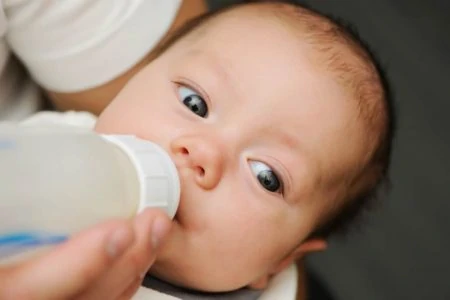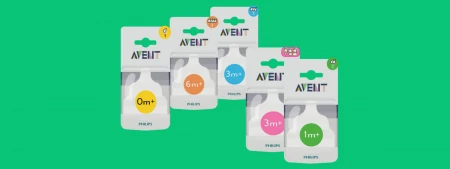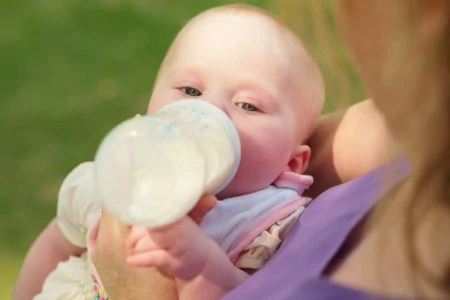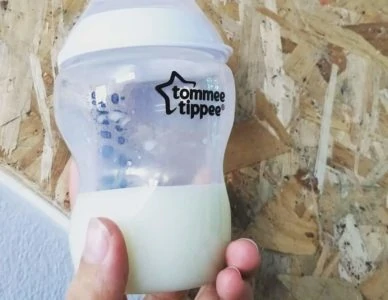It can be difficult to know when to switch to a new nipple size on your baby bottles. If the nipple flow is too fast, your baby may end up choking, gagging, and swallowing too much air. If it’s too slow, they’ll tire of struggling to get enough milk.
We’ve reviewed the advice from doctors and lactation consultants to help you make this decision.
We’ll discuss the preferable nipple sizes for formula-fed and breastfed babies, including those for whom you’re exclusively pumping. We’ll show you how to recognize when it’s time to switch the nipple flow. We’ll also explain other reasons your baby may be fussy during bottle feeds.
Key Takeaways
- The nipple size chosen for baby bottles depends on factors such as whether the baby is formula-fed or breastfed, their age, and other readiness cues.
- For formula-fed babies, nipple size determines milk flow rate, with slower flow for 0-3 months, medium flow for 3-6 months, and fast flow for 6-12 months. However, age is not always the best determinant of nipple size, and other signs such as sucking hard, flattening the nipple, and getting agitated should also be considered.
- For breastfed babies, experts recommend using slow flow or “newborn” nipples, as the bottle flow should reflect breast milk flow and to avoid overfeeding.
- For babies who are exclusively pumped, it’s important to assess your milk flow and determine what will work for your baby.
When To Switch Bottle Nipple Sizes
The nipple size you choose for your baby’s bottles will depend on several factors, such as whether they are formula-fed or breastfed, their age, and other readiness cues. Nipple size determines the milk flow rate.
For A Formula Fed Baby
Most baby bottles include an age guide for nipple sizes (flow). If you no longer have this information, the manufacturer should have this guide posted on their website.
Faster nipple flow sizes are meant for older babies because they eat more at each feeding and can handle the flow of milk better. Most manufacturers follow this guideline:
- Slow flow: 0-3 months
- Medium flow: 3-6 months
- Fast flow: 6-12 months
However, age isn’t always the best determinant of nipple size, as all babies are different. There are other signs besides age to indicate when your baby is ready to move up a size, such as:
- Sucking hard.
- Flattening the nipple.
- Getting aggravated (squirming, kicking, pushing the bottle away, etc.).
- Smacking at the bottle.
- Taking a long time to feed (30 minutes or more).
- Eating less at feedings but getting hungry again soon after.
If your baby isn’t showing any signs of frustration and isn’t taking long to empty their bottle, it is unnecessary to move up a size. But if your baby is showing some of these signs, try the next size up. It’s all about trial and error.
If you do move up a size and your baby is gagging, coughing, choking, or dribbling milk while feeding, the nipple flow is too fast, and you will need to go back down a size. You may also need to move back down a size if your baby is exceptionally uncomfortable shortly after feedings, as the faster flow may be too much for their digestive tract (1).
For A Breastfed Baby
Experts recommend using slow flow or “newborn” nipples when bottle feeding a breastfed baby. Typically, you should never have to move up a nipple size for a breastfed baby.
Breastfed babies have to work for their milk when at the breast, and breasts usually release milk much slower than a bottle nipple. If you give your breastfed baby a fast-flow nipple, they may start to get lazy or even refuse the breast. Essentially, the bottle flow should reflect breast milk flow.
It’s also easy to inadvertently overfeed a breastfed baby when bottle feeding. Caregivers should be sure to mimic breastfeeding as much as possible by feeding their baby in a more upright position, changing positions midway through feeds, and practicing paced bottle feeding.
Even though most breastfed babies should never have to move up a nipple size, in certain cases, a faster flow nipple might be a more suitable option. For example, if your breasts seem to have a fast flow and your baby can nurse in five to ten minutes, they may get frustrated with bottles that take 30-45 minutes to finish.
Assess your milk flow, and determine what will work for your baby. If everything is running smoothly, there’s no need to make any changes.
What if I’m Exclusively Pumping?
Because breast milk digests quicker than formula and it’s easy to overfeed a baby when bottle feeding, experts still recommend using slow flow or “newborn” nipples, even if you’re exclusively pumping. Just like when breastfeeding, feed your baby on demand (not according to a rigid schedule), and follow paced bottle feeding methods.
Typical nursing sessions last 15-20 minutes, so expect your feedings to take around that same amount of time. Allow your baby plenty of time to drink their bottle (2).
Other Considerations
If your baby seems unhappy with their current nipple size but doesn’t respond positively to a faster flow nipple, there may be other factors to consider. You may want to try switch your bottles or nipples to those of a different shape (such as an orthodontic or angled nipple), texture, length, or venting system.
A “preemie nipple” doesn’t necessarily mean it has a slow flow. And some brands don’t go by age but rather label the nipples by levels. You’ll need to read the packaging or even check the manufacturer’s website to get a feel for what these labels mean.
Editor's Note:
Michelle Roth, BA, IBCLCThe problem might not be with the equipment itself. Your baby may be going through a distracted phase, teething, having a medical issue, or they might be unhappy with the milk’s temperature. You may also have high lipase in your breast milk, which can bother some babies (3).
FAQs
Keep The Size Right
Knowing when to switch nipple flows will help make feedings faster, easier, and much more enjoyable for everyone. The best nipple size may depend on if your baby is formula-fed or breastfed, their age, and other readiness cues.
Just as babies are all different, so are their feeding needs. Assess your situation, and figure out what will work best for you and your baby. If everything is going smoothly with your current nipple size, there’s no need to switch.











